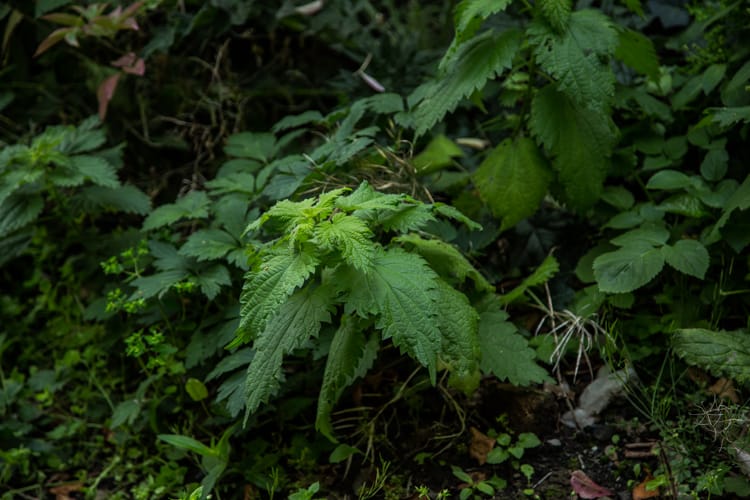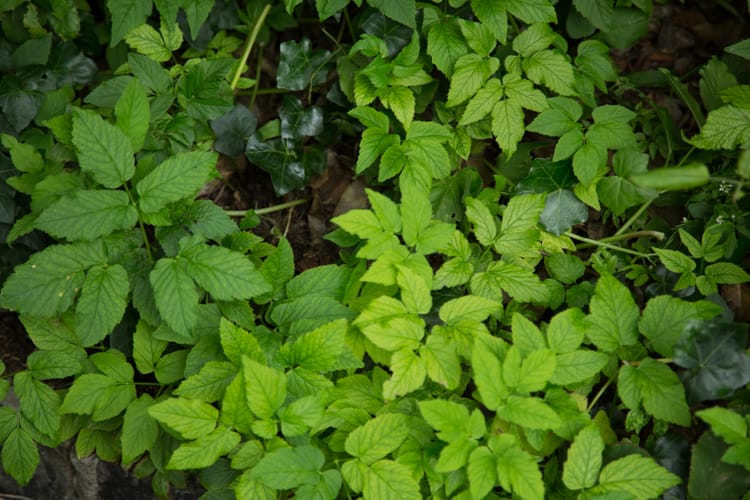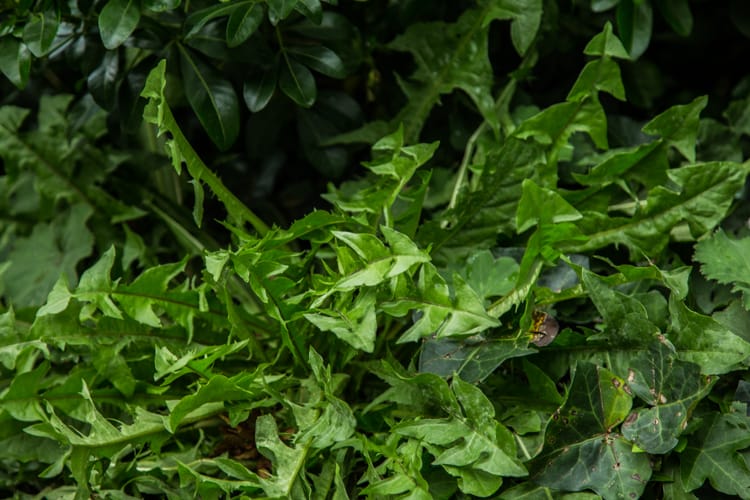What’s the best way to tell area residents about plans for a new asylum shelter nearby?
The government should tell communities directly about plans for new asylum shelters, some activists and politicians say.
Chickweed and hairy bittercress salad, anybody? Chef Niall O’Sullivan shares the delights of foraging in Dublin’s inner city and on its fringes.

Just before we reach Merrion Square, Niall O’Sullivan stops at a flower bed in front of an office building. He points to a leafy green plant that’s growing underneath the well-permed decorative trees.
“Chickweed. Every gardener’s nightmare,” says O’Sullivan. He plucks some from the compost.

This is a succulent salad leaf that has a nice water burst when you eat it, he says. “It doesn’t have a lot of flavour, but if you treat it in conjunction with bitter leaves and some sour leaves, it works really, really well.”
It is a Thursday afternoon and O’Sullivan, chef at Merrion Row’s Bang restaurant and founder of the foragers-in-chief Nádúr Collective, is explaining how Dublin has so much pickable food to offer.
“Every time of the year, you just have an abundance. As a chef it just keeps you so much more in tune with the seasons,” he says.
Every plant has a unique flower and this is one of the key elements to identifying edible plants. If you’re unsure of a plant’s identity, O’Sullivan recommends waiting until it flowers. He points to the distinct, tiny star-shaped white flowers of the chickweed.
We’re seconds through the gates of Merrion Square, and O’Sullivan spots another salad leaf. This time it’s hairy bittercress, which is similar to watercress. “It’s absolutely delicious,” says O’Sullivan.
He suggests combining this peppery leaf with chickweed and some more bitter wild leaves, like sorrel and the “highly overlooked” dandelion.
During one of the collective’s foraging walks, an Italian man told O’Sullivan that he was surprised at how people here trample on dandelions without a second thought. “In Italy, dandelions with chilli, garlic and olive oil was one of his first childhood memories of food,” he explains.
But dandelions aren’t the only under-appreciated weed in Ireland; nettles are left to rot in the ground as well. O’Sullivan admits that nettles aren’t the most flavoursome of foods, but in terms of nutritional value, he says they are hard to beat.
With vitamins, minerals, high amounts of protein, and some anti-inflammatory properties, nettles ticks a bunch of boxes. Some people even sting themselves on purpose to fast-track vitamins into their bloodstream, he said.

“Anything you have in abundance, you don’t want,” he comments. Looking abroad again, nettles would be considered an expensive superfood in places where they are less common. “You only see it in the fine-dining restaurants in Australia,” he adds.
Though we didn’t come across any wild garlic, which isn’t hard to find in some of Dublin’s bigger parks, O’Sullivan did find some other aromatic ingredients among the greenery of Merrion Square.
He breaks up the leaves of some Jack-by-the-hedge. Known as a mild alternative to garlic, its scent is still strong. “You can blitz it and make pesto. Or if you’re making a soup or a salad, pick some of the smaller leaves and put them through and you’ll get a lovely, fresh garlic hit,” he says.
He looks for some Alexander, with leaves that taste like celery, and flowers similar to black pepper. It’s too early in the season to find it, but it’s recognisable by its jet black flowers. He does, however, spot some ground elder, a minty plant perfect for adding to pea soup.

The Nádúr Collective was started by O’Sullivan and two other chefs, Paul Quinn and Dave Gallagher. They do guided foraging walks a few times a year, mostly in Wicklow, but sometimes in the city as well.
It was the MAD Symposium, an annual food convention that has taken place in Copenhagen since 2011, which sparked their interest in foraging. “We started realising there’s actually an abundance of ingredients that we’d never heard of or seen before. It was kind of exciting finding stuff; new ingredients and new tastes,” explains O’Sullivan.
Over in Denmark, wild food has become popular, and he puts this down to their bitter palate. Irish people have moved towards a love of sweet things; most foraged foods aren’t sweet. “Sugar has taken over,” he says.
Ed Hick runs a butcher shop in Dún Laoghaire and has picked wild food since he can remember. But he says that most of the people he comes across when he’s picking mushrooms aren’t Irish.
Irish people have become disconnected from what they eat, and knowledge about wild food hasn’t been passed on to current generations, he believes.
“Our grandparents would have been fundamentally engaged with what they were eating,” he says.
Every autumn, Hick gets together with some of his customers to go berry picking. This year, there were about 25 takers, and he showed them how to make jam afterwards.
Farmers often create hedges by interweaving various berry bushes, he says. “They all tend to grow in the one hedge. Most people recognise the blackberries, but not necessarily the berries on the other bushes.”
After collecting an assortment of berries – elderberries, rowan berries, blackberries, haws, damsons, fraughans and sloe berries – Hick transformed them into jams and chutneys. Though he added the sloe berries to some gin, of course, and used some fraughans to make marshmallow. “Crab apple and rowanberry jelly works really well with pork as well,” he adds.
In Merrion Square, elderberries are to be seen throughout the park. Elderberry is common all around the country, because it was thought to ward off spirits in the past, explains O’Sullivan. “And Harry Potter’s wand was made from an elder; it’s magic,” he laughs.
“During the summer you get the flowers for beautiful cordial, champagne, ice cream sorbet,” he says. “The green berries can be picked, salted, brined and turned into little capers.”
When they go black, they shouldn’t be eaten raw, he warns. But they are perfect for making elderberry sauce, cordial, jam, chutney, vinegar or tea.
“It’s not coincidence that these things come around,” says O’Sullivan. “Elderberry is amazing for keeping off colds and flu.”
It’s also the time of year for meats like game and venison. Elderberries are the perfect accompaniment to these, as are blackberries. “As they say, things that grow together, go together,” he adds.

For those of us willing to travel to the edges of Dublin, another world of wild food is available. In the woods, a plant called woodruff would appeal to those with more of a sweet tooth. With a flavour similar to that of marzipan, it can be fused with cream to make custard or ice cream.
“It’s related to the sticky-back plant you throw at your enemies when you’re in school,” says O’Sullivan. “It’s absolutely delicious.”
For anyone going for walks along the beach, keep an eye out for Dublin’s sea vegetables. There’s sea beet, which is similar to spinach, and sea purslane, which is a salty green plant.
“You’ve got sea buckthorn, which is a berry that grows on a really thorny bush . . . It’s bright orange and has a flavour kind of like passion fruit. It’s really, really tart, but I think it’s an amazing ingredient,” he says, adding that there’s no need to look overseas for tropical tastes.
Sea vegetables are available all along the coast from Howth to Greystones, says O’Sullivan. But for other wild foods in Dublin, he recommends exploring the Phoenix Park.
He also stresses the importance of asking for permission from landowners before picking, although he is yet to meet any that have turned him down.
Though some people are uncomfortable with eating food grown in a polluted city, O’Sullivan isn’t. (Though we wouldn’t recommend eating plants picked from places where Dublin City Council is likely to have sprayed weedkiller.) He’s more worried about the possibility of picking the wrong plants.
“You have to be aware of the dangers. There’s fatal plants out there, and knowing what you’re doing is vitally important,” he says.
It’s easy to make dangerous mistakes. For example, O’Sullivan points out that while common hogweed is edible, giant hogweed causes really severe skin burns.
Hick recommends an old pocket book called Food for Free by Richard Mabey. (You can get it in one of Dublin City Council’s libraries). It features the most common wild foods you’ll come across with photos and details on how to identify them.
“You just need to become familiar with them,” advises Hick.
Since it began, the Nádúr Collective has branched out into education and art installations. It has been working with a cookery school to bring young chefs out foraging. “You have a lot more respect for what’s going on if you pick it yourself,” says O’Sullivan.
But why is this something that has to be taught? The time of mammies passing on their knowledge of foraging and cooking is gone, says Hick, and people rely too much on cooking books and programmes.
“You’ve got all these things, but people almost feel disempowered by them,” he says. “Nothing you do is more intimate than eating . . . It’s hard for me to fathom how people are so disconnected from it.”
O’Sullivan wants to do more work in schools and wouldn’t mind becoming Ireland’s own Jamie-Oliver-style advocate. Later this month, in Dublin Castle, he will be doing a workshop for children about vegetables and wild plants.
“It’s actually mind-blowing how much kids will be subjected to advertising and they’ll know logos for everything from Facebook to McDonald’s or Burger King, but then they won’t know what celery or a carrot is,” he says. “Because you’re working with food all the time, you presume people know this stuff – but they don’t.”
The Nádúr Collective will be doing a workshop for children in Dublin Castle on 24 October, and a class on preservation techniques for foraged food in the Fumbally on 25 October.
[UPDATE: This article was updated on Thurs 8 Oct at 14.17 to include a sentence advising readers not to eat plants from places where city council sprays weedkiller. We don’t want to be responsible for that.]